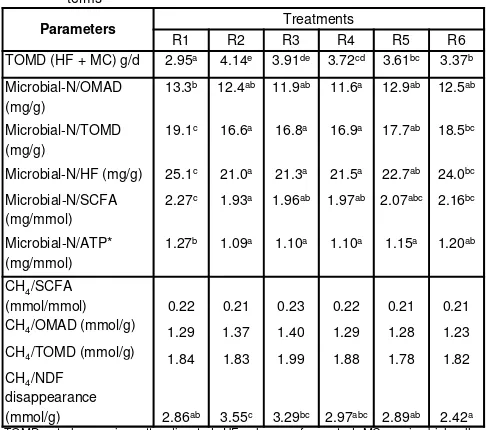METHANE PRODUCTION AND EFFICIENCY OF FEED ENERGY
UTILIZATION BY INCLUSION OF UREA TREATED COCOA FEED AS
BARLEY GRAIN SUBSTITUTION IN RUMINANT RATION
Despal
D
t A i
l N t iti
& F
d T
h
l
F
A i
l S i
B
A i
lt
l
BACKGROUND
According to US-EPA (2009), enteric fermentation in ruminant stomach is the largest anthropogenic
source of CH
4emissions in the United States in year 2007 (24 percent of total CH
4emissions). The gas
represent energy loses and therefore reduced feed energy efficiency (Pelchen and Peters, 1994). Methane
Dept. Animal Nutrition & Feed Technology, Fac. Animal Science, Bogor Agricultural
University, Indonesia Jl. Agatis, Kampus IPB Darmaga, 16680 Bogor email:
despal@ipb.ac.id
]
production was higher in ruminant fed low quality feedstuff such as cocoa pod, the major feed resources
available in Indonesia. In opposite, feeds that allow a high efficiency of microbial protein cell synthesis
produce low amounts of methane per unit of feed digested (Leng, 1982). Improvement fibrous feed quality
using urea treatment (Chenost, 2001) can reduce up to 20% of CH
4emission and improve feed energy
conversion simultaneously. Despal (2005) have been found that 20 g urea per kg cocoa pods (w/w fresh
material) improved cocoa pods digestibility better than applications of 10 and 30 g urea.
METHODS
The improved urea treated cocoa pod (CPs) was used as substitute (0, 25, 50, 75 and 100%) of
p
p
(
)
(
)
barley enriched with soybean (barley) in ruminant ration. The study was conducted in rumen simulation
technique according to Czerkawski and Breckendridge (1977) procedures (figure 1) to observe the effect of
the rations on CH
4production and energy feed utilization by rumen microbial. Composition of the rations fed
daily to fermenters were 10 g hay as basal ration (R1), 10 g hay + 4 g barley (R2), 10 g hay + 3 g barley + 1
g CPs (R3), 10 g hay + 2 g barley + 2 g CPs (R4), 10 g hay + 1 g barley + 3 g CPs (R5) and 10 g hay + 4 g
CPs (R6).
Treatment
Table 1: Effect of replacing barley/soybean meal-mixture by urea treated cocoa pod on fermentation characteristics in Rusitec
RESULTS
Parameter Treatment
R1 R2 R3 R4 R5 R6
PH 6.63d 6.51a 6.52ab 6.54b 6.59c 6.63 d
Protozoa (cts/ml)
17475 17868 16310 14267 13672 12436
CH4(mmol/d) 5.45a 7.51de 7.71e 6.95cd 6.38bc 6.02ab
NH4+(mmol/l) 5.64a 8.31d 7.42c 7.28c 6.68b 6.48b
SCFA
(mmol/d) 24.88a 35.61b 33.59b 31.94ab 30.94ab 28.78ab
acetate 14.46a 18.84b 18.47b 17.85ab 17.80ab 17.26ab
Up to 25% of cocoa pods could replace barley grain in
ruminant ration. Decreasing CH
4production in ration
contained > 25% urea treated cocoa pod were caused by
the low activities of microbial which lead to low digestibility
and feed efficiency.
propionate 6.07a 9.20b 8.57b 7.76ab 7.52ab 6.59a
iso-butyrate 0.17 0.25 0.18 0.16 0.15 0.20 n-butyrate 3.02 5.14 4.58 4.45 3.94 3.41 iso-valerate 0.60a 1.12d 0.98cd 0.88bc 0.79abc 0.70ab
n-valerate 0.56 1.06 0.81 0.84 0.75 0.63
Microbial cells (mgDM/d) 700
a 859c 821b 782b 793b 776b
[image:1.612.317.557.388.572.2]CH4 = methane; NH4+ = ammonia concentration; SCFA = Short chain fatty acid; different superscript at the same row represent significantly different at P < 0.05.
Table 2: Efficiency of microbial protein synthesis expressed in different terms
Parameters Treatments
R1 R2 R3 R4 R5 R6
TOMD (HF + MC) g/d 2.95a 4.14e 3.91de 3.72cd 3.61bc 3.37b
Microbial-N/OMAD (mg/g)
13.3b 12.4ab 11.9ab 11.6a 12.9ab 12.5ab
Microbial-N/TOMD (mg/g)
19.1c 16.6a 16.8a 16.9a 17.7ab 18.5bc
Microbial-N/HF (mg/g) 25.1c 21.0a 21.3a 21.5a 22.7ab 24.0bc
Microbial-N/SCFA (mg/mmol)
2.27c 1.93a 1.96ab 1.97ab 2.07abc 2.16bc
Microbial-N/ATP* (mg/mmol)
1.27b 1.09a 1.10a 1.10a 1.15a 1.20ab
CH4/SCFA
(mmol/mmol) 0.22 0.21 0.23 0.22 0.21 0.21 CH4/OMAD (mmol/g) 1.29 1.37 1.40 1.29 1.28 1.23
CH4/TOMD (mmol/g) 1 84 1 83 1 99 1 88 1 78 1 82
REFERENCES
Chenost, M., 2001: Optimizing the use of poor quality roughages through treatments and supplementation in warm climate countries with particular emphasis on urea treatment.
http://www.fao.org/ag/AGA/AGAP/FRG/ECONF95/HTML/CHENOST. HTM. [Download: August 10th, 2004].
Czerkawski, J.W. and Breckenridge, G. 1977. Design and development of a long-term rumen simulation technique (rusitec).British J. Nutr. 38, 371 –374.
Despal; 2005. Nutritional Properties of Urea Treated Cocoa Pod for Ruminant Cuvillier Verlag Goettingen
4 ( g) 1.84 1.83 1.99 1.88 1.78 1.82
CH4/NDF
disappearance
(mmol/g) 2.86ab 3.55c 3.29bc 2.97abc 2.89ab 2.42a
Ruminant. Cuvillier Verlag, Goettingen.
Leng, R. A., 1982: Modification of rumen fermentation. In: Hacker, J.B., (Eds.): Nutritional Limits to Animal Production from Pastures. Commonwealth Agricultural Bureaux, Farnham Royal, UK. pp.427-453.
Pelchen, A.; Peters, K.J., 1994: Pollutant gases from animal farming -Influences on the greenhouse effect. Natural Resources and Development. Institute for Scientific Co-operation, Tübingen.40, 56-68. US-EPA. 2009. Inventory of U.S. Greenhouse Gas Emissions and Sinks:
1990 – 2007. EPA 430-R-09-004. [Download: November 9th, 2009]
[image:1.612.55.298.509.724.2]